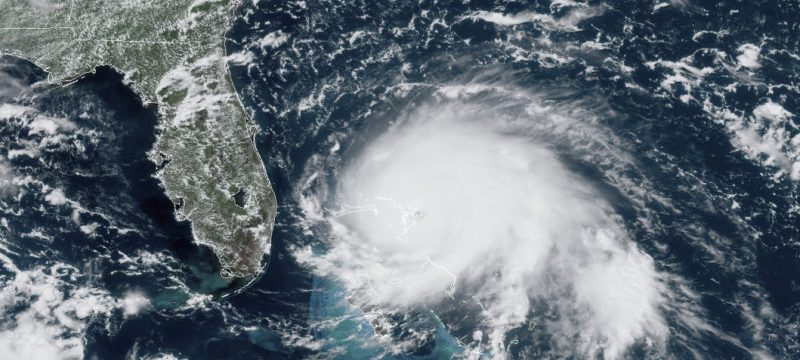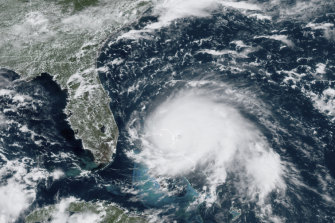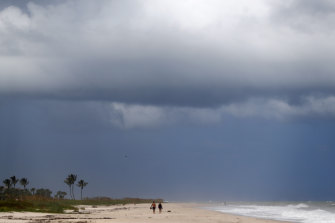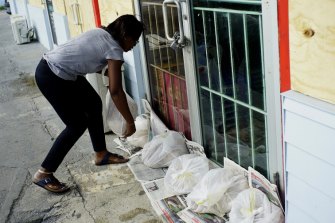Titusville, Florida: Hurricane Dorian crashed into the Bahamas on Sunday as the second strongest Atlantic storm on record and inched closer to the United States, with parts of Florida evacuating and Georgia and the Carolinas bracing for wind and flooding.
The US National Hurricane Centre (NHC) said Dorian made landfall on Elbow Cay in the Abaco Islands as a Category 5 storm with maximum sustained winds of 295km/h and gusts of more than 354km/h. It made a second landfall on Great Abaco Island near Marsh Harbour.
A satellite image shows Hurricane Dorian churning over the Atlantic Ocean on Sunday.Credit:NOAA via AP
Millions of people from Florida to North Carolina were bracing to see whether Dorian avoids a US landfall and veers north into the Atlantic Ocean. Even a glancing blow from one of the strongest storms ever to menace Florida could bring torrential rains and damaging winds, and "a Florida landfall is still a distinct possibility," the Miami-based NHC warned.
Bahamas residents reported trees snapping and docks being destroyed before the brunt of the storm arrived. The pummelling was expected to last for hours as the hurricane slows, "prolonging its catastrophic effects," the NHC said.
On Great Guana Cay, just off Great Abaco Island, waves began washing over low-lying parts of the tiny 14-kilometre strand of land by mid-morning, resident Tom Creenan said.
The largely deserted Vero Beach in Florida on Sunday.Credit:AP
Although some residents left for Nassau and elsewhere days ago, some 200 to 300 are riding out the storm on Great Guana Cay, where power was already out and forecasters are predicting up to 61 centimetres of rain and seven-metre storm surges.
"The other day the Prime Minister came out and said everybody in Abaco should leave," Creenan said by phone. "But there's no place to go.
"This is the strongest hurricane that's ever hit in the Bahamas. I grew up in Florida, so I've been through Andrew."
Hurricane Andrew slammed into eastern Florida in 1992 as a category 5 storm on the five-step Saffir-Simpson Wind Scale, obliterating the town of Homestead.
Yolande Rolle sandbags her shop as she prepares for the arrival of Hurricane Dorian in Freeport on Grand Bahama on Sunday.Credit:AP
Doriam ties with Gilbert (1988), Wilma (2005) and the 1935 Labour Day hurricane for the second strongest Atlantic hurricane on record based on maximum sustained winds.
Dorian is the strongest hurricane on record to hit the north-western Bahamas.
Florida was taking no chances with Dorian and four Florida counties, including Palm Beach County, issued mandatory evacuations for some residents, including those in mobile homes, on barrier islands and in low-lying areas. Other coastal counties have announced voluntary evacuations.
US President Donald Trump said on Sunday that the storm would likely impact the eastern seaboard from Florida to North Carolina.
"This looks monstrous," Trump said during a briefing with the Federal Emergency Management Agency (FEMA). "This looks like it could be larger than all of them."
FEMA is moving food, water and generators into the south-eastern United States, said acting Administrator Peter Gaynor.
"When it comes to response, we are more than ready to deal with anything that Dorian delivers us this year, or any other storm that may come this season," he told CNN.
Meanwhile, a new tropical storm has formed south-west of Mexico and is expected to become a hurricane on Monday. Tropical Storm Juliette is 735 kilometres from Manzanillo, Mexico, with maximum sustained winds of 75 km/h, the NHC said on Sunday.
Reuters
Source: Read Full Article



